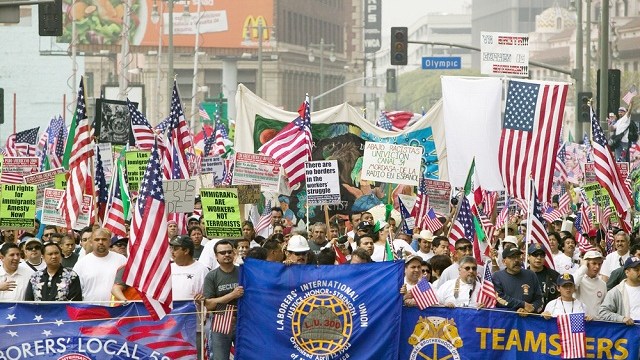How Barbara Kruger Asks the Questions This Election Must Answer

Every election comes with questions, ranging from the serious (How will we fix the economy?) to the ludicrous (Was he born in this country?). But this election season, artist Barbara Kruger is asking the open-ended questions that this election (and every election) must answer in her exhibition Belief+Doubtat the Hirshhorn Museum in Washington, DC. Using her standardmodus operandiof larger-than-lifesize text, Kruger grabs your attention at the very moment that attention must be paid in America. Although Kruger is asking these questions, the real question might be whether we are ready to answer them.
Although Kruger began working as an artist in the 1970s, after a career in magazine design, she hit upon his signature style of text in red, black, and white in the 1980s. Pictures quite often accompanied some of her text, including Kruger’s famous 1987 workUntilted (I shop therefore I am), in which a hand holds a red card with the text in red. The themes of American consumer culture and how that consumer culture has corrupted our political landscape appear throughout Kruger’s work, and continue in Belief+Doubt.
The Hirshhorn asked Kruger to cover 6,700 square feet of their lower level lobby and the museum’s bookstore. Vinyl wallpaper covered with Kruger’s red, white, and black text motif wraps around every surface, including the escalators, which read “MONEY MAKES MONEY” and “YOU WANT IT. YOU BUY IT. YOU FORGET IT.” The two escalators visually intersect in profile, making the two messages collide in a supply and demand chart you’ll never forget, even though Kruger layers the message “FORGET EVERY THING” across the lobby right where the escalators meet. It’s a dizzying delivery system of messaging, but Kruger’s approach knocks you into cognitive dissonance just long enough to realize you’ve been knocked dizzy by the political messaging all along without ever realizing it.
The temptation that many critics will fall into will be to label Kruger’s exhibition as a liberal lovefest. Judging from comments in interviews, I’d bet that Kruger’s politics lean towards the liberal end of the spectrum, but Belief+Doubt always asks open-ended, politically neutral questions that we read as favoring one party or the other because of our own bias. I’ll admit that Kruger’s phrase “A RICH MAN’S JOKES ARE ALWAYS FUNNY” made me think of Mitt Romney’s sometimes unfortunate comedy stylings. But a conservative viewer would see “WHOSE VALUES?” (which appears above the escalators and “FORGET EVERY THING”) and nod in assent that this election is about values—moral, religious, ideological, etc.
When I first heard that Kruger would have an exhibition at the Hirshhorn, a national museum under the umbrella of the Smithsonian Museums, I anticipated a political clash over tax dollars going to “subsidize” or “promote” what some would perceive as “liberal” politics. But the message of the exhibition goes beyond specific viewpoints and to the nature of viewpoints itself. The title work of the exhibition (shown above) boils it all down to the simple equation of “BELIEF+DOUBT=SANITY.” “It is important for us all to try to live an examined life and understand why things are the way they are,” Kruger explains, harking all the way back to 399 BCE, when Plato (in his Apologia) quoted his teacher Socrates saying that the unexamined life is not worth living. True sanity, Kruger suggests, comes from the healthy balance of faith and disbelief born of an examined life. The unbalanced fall into the zealotry of blind belief or the hopeless nihilism of kneejerk rejection. When so many Americans belong to one of those two camps, democracy fails. Kruger’s Belief+Doubt amounts to nothing less than a love letter to the American experiment.
If you look up as you ride one of the escalators in the exhibition, you’ll see the message “DON’T LOOK DOWN ON ANYONE.” Barbara Kruger’s exhibition Belief+Doubt looks down on neither the Democrats nor the Republicans, but instead asks us to all look inside of ourselves and to ask the hard, necessary questions of this election and our country. Instead of looking down at the people on the other side of the political fence, Belief+Doubt contends that the best course of action is to reach across. Anything less is insanity.
[Image:Barbara Kruger, Belief+Doubt, 2012. © Barbara Kruger. Photo: Cathy Carver.]
[Many thanks to the Hirshhorn Museum in Washington, DC, for providing me with the image above and other press materials related to Barbara Kruger’s exhibition Belief+Doubt, which runs through December 31, 2014.]





